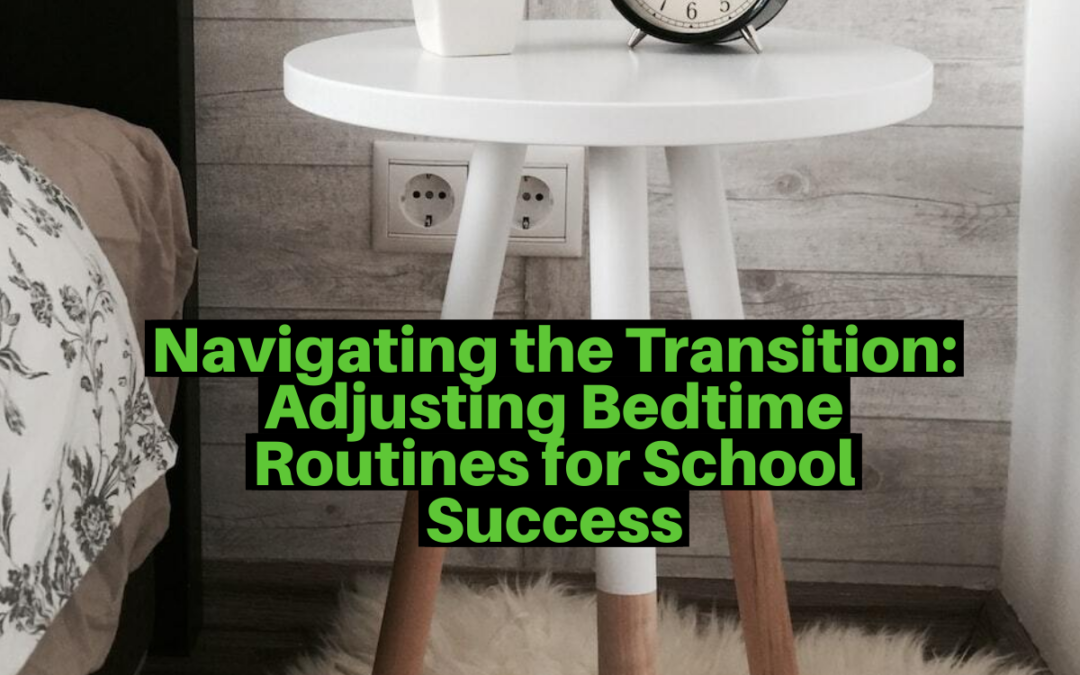This post may contain affiliate sales links.
With the start of a new school year, it’s important to establish a consistent and healthy bedtime routine. A well-rested mind and body are essential for academic performance, focus, and overall well-being. However, transitioning from a relaxed summer schedule to a structured school routine can be challenging. In this blog post, we will explore practical strategies to help you and your family adjust bedtime routines smoothly, ensuring a restful night’s sleep and a successful school year.
-
Gradual Transition:
Start adjusting your bedtime gradually a week or two before the school year begins. Each night, move bedtime 15 minutes earlier until you reach the desired school bedtime. This gradual transition allows your body to adapt to the new schedule without sudden disruptions, making the adjustment process easier.
-
Consistent Sleep Schedule:
Establish a consistent sleep schedule, aiming for the recommended 7-9 hours of sleep for school-aged children and 8-10 hours for teenagers. Determine the time you need to wake up for school and work backward to determine an appropriate bedtime. Consistency helps regulate your body’s internal clock and improves the quality of sleep, ensuring you feel refreshed and alert in the morning.
-
Wind-Down Routine:
Create a wind-down routine to signal to your body that it’s time to relax and prepare for sleep. This routine should be consistent and include activities that promote relaxation. Consider incorporating calming activities such as reading a book, taking a warm bath, practicing deep breathing exercises, or listening to soft music. Avoid stimulating activities like screen time or intense physical exercise close to bedtime, as these can disrupt sleep patterns.
-
Limit Screen Time:
The blue light emitted by electronic devices can interfere with the production of melatonin, a hormone that regulates sleep. Establish a “screen curfew” by limiting electronic device usage at least an hour before bedtime. Encourage activities that do not involve screens, such as reading, journaling, or engaging in quiet conversations, to promote a more peaceful transition to sleep.
-
Create a Sleep-Friendly Environment:
Design a sleep-friendly environment that promotes relaxation and quality sleep. Keep your bedroom cool, dark, and quiet, as these conditions are conducive to optimal sleep. Consider using blackout curtains, earplugs, or a white noise machine to create a peaceful atmosphere. Invest in a comfortable mattress, pillows, and bedding to enhance sleep quality and overall comfort.
-
Avoid Caffeine and Heavy Meals:
Caffeine and heavy meals close to bedtime can interfere with sleep patterns. Limit caffeine intake, especially in the late afternoon and evening, and opt for decaffeinated beverages instead. Additionally, avoid large meals or spicy foods right before bed, as these can cause discomfort and make it harder to fall asleep.
-
Establish a Morning Routine:
A smooth transition to the school routine involves not only adjusting bedtime but also establishing a consistent morning routine. Wake up at the same time each day, allowing yourself enough time to prepare for the day ahead. Start the morning with a balanced breakfast, engage in light physical activity, and allocate time for personal hygiene and getting dressed. A structured morning routine sets a positive tone for the day and helps you feel more prepared and focused.
Adjusting bedtime routines for school is a vital step in ensuring a successful and productive academic year. By implementing these strategies, you can ease the transition from a relaxed summer schedule to a structured school routine. Remember that consistency, gradual adjustments, and creating a sleep-friendly environment are key to achieving restful nights and energized mornings. Prioritize your sleep, and watch as improved rest and well-being positively impact your school performance and overall quality of life.


